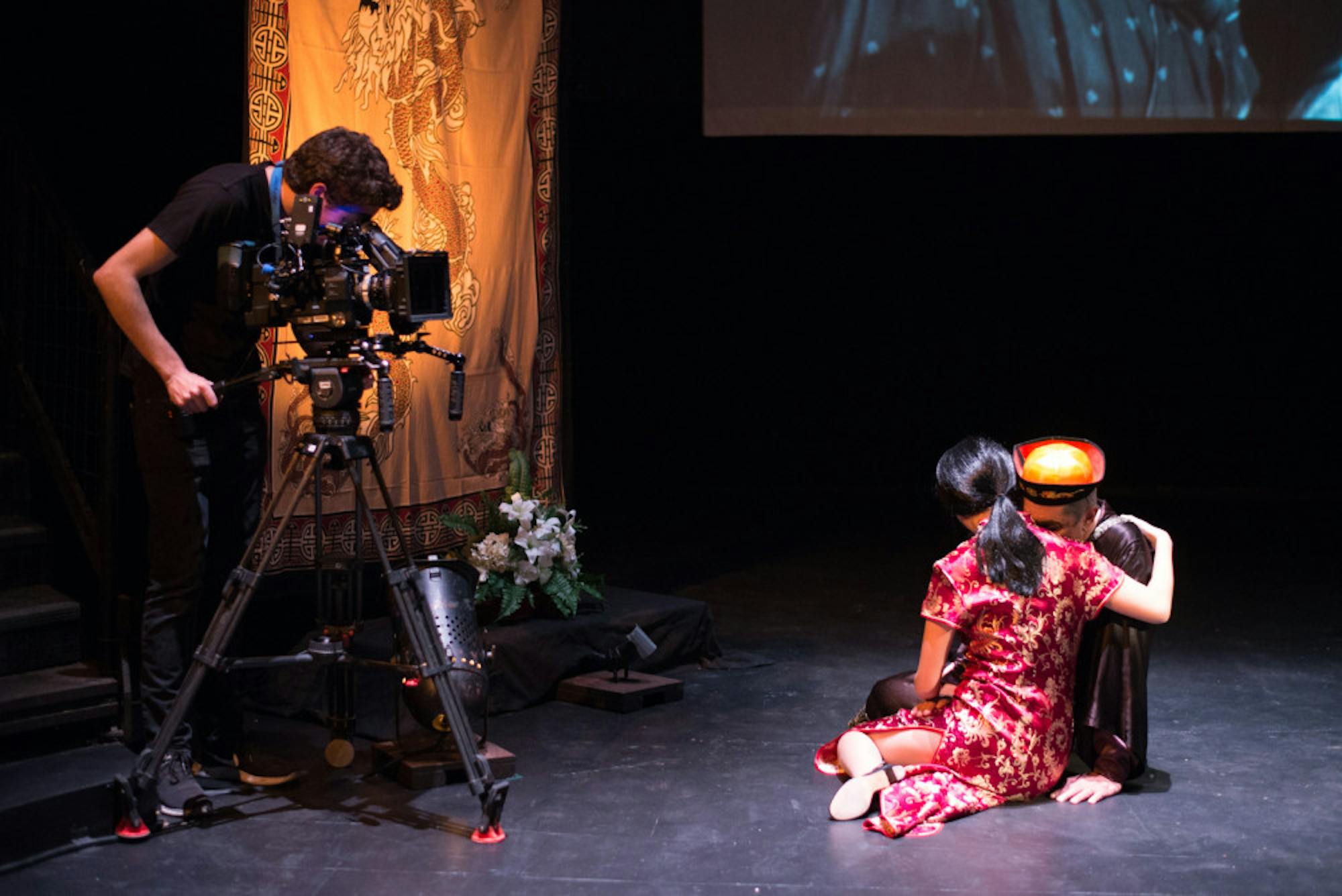Written and directed by graduating senior Cinthia Chen, "Anna May Wong: The Actress Who Died a Thousand Deaths" comments on racial issues in Hollywood and tells the story of Asian-American actress Anna May Wong. The show was produced as an International Literary and Visual Studies senior thesis, in collaboration with Film and Media Studies and the Department of Drama and Dance.
The first and only performance of the production, attended by 170 people, took place on the evening of April 28 in Balch Arena Theater of Aidekman Arts Center and was sponsored by Diversity Fund, Undergraduate Thesis Fund and the Talamas Study Film Sponsorship Program.
The play was an example of “live cinema theater,” which incorporates traditional filmmaking techniques with those of drama to create unique cinematic and theatrical effects. The performance was filmed live onstage and simultaneously projected onto a screen in the theater, featuring the audience in the background. Opening and closing sequences from “Daughter of the Dragon” (1931), in which Wong starred as Princess Ling Moy, were also projected onto the screen.
The performance's story begins with older Anna May Wong, played by Harvard University graduating senior Karoline Xu, returning from her trip to China and realizing that she is unhappy with the stereotypical roles offered to Asian women in Hollywood, which limit and confine her as an actor and person who is ambitious and independent.
Soon after, Wong drinks herself to sleep on her couch and is transported back in time to when she starred in “Daughter of the Dragon." She plays the stereotypical role of Princess Ling Moy, an Asian woman who is left dead by the film's end and whose father is played by a white man. In the dream, older Anna May Wong watches her younger self, played by rising sophomore Natalie Hwang.
Although Wong tells her peers about her inner conflicts as an actress who is not allowed to play roles outside of her racial boundaries, she finds herself even more frustrated by their responses. Warner Oland, a white male actor who plays Princess Ling Moy's father in the 1931 movie and who is played by Boston-area actor Arthur Barlas, tells her, “You are too Chinese to play Chinese.”Even her sister, Maria Wong, advises her to star in Hollywood movies instead of flicks she refers to as "B movies," which would allow her to play roles she wanted, such as a surgeon.
The production also highlights the traditional values held by many Asian immigrant parents at the time, who favored sons over daughters and did not appreciate art as a career path. In a dialogue between Anna May Wong and her father Wong Sam Sing, played by Boston-area actor Anthony Eng, he says, “I always wanted a son" and "I never liked you going into acting.” However, the dialogue comes to an endearing conclusion in which Wong's father shows his deep affection for his daughter. "I might disagree with your life choices, but you are my daughter," he says, to which she replies with a smile, "You are proud of me."
At the show's climax, older Anna May Wong begins to direct "Daughter of the Dragon" in the way she wants, altering the plot of the movie. As Wong takes the camera, the black and white projection on the screen transforms into color, revealing her sense of freedom and independence from the stereotypical roles she used to have to play.
"Anna May Wong: The Actress Who Died a Thousand Deaths" concludes with older Anna May Wong waking up from her dream and deciding to take roles that would allow her to express herself.
Chen's production succeeds in creating a unique theatrical experience. With the audience included in the background of the scenes projected onto the screen, they are immediate witnesses to Wong's inner conflicts. This thematically alludes to Wong's role as an actress, whose job was to be seen and watched.
The production's use of live cinema theater makes the show visually interesting while giving the events a unique setting. Members of the film crew -- who move around on stage during the performance as they film the actors -- are more than technicians and engineers; they become participants in the performance.
The performance, which lasted approximately 45 minutes, was followed by a question-and-answer session between the cast and crew and the audience, moderated by Associate Professor in the Department of Drama and Dance Monica Ndounou.
Ndounou applauded the show for its success in integrating two different artistic mediums and telling the story of an actress of color.
“It is an important production … in terms of form in merging live cinema and theater. [Chen] is merging forms in a way that is conducive to the story she is telling, so it allows her to tell the story that is taking place on the screen and film that Anna May Wong appeared in,” Ndounou said. “It tells us a lot about the inner life of an Asian-American woman who was not often … perceived in more in-depth ways. This form allows [Chen] to demonstrate the humanity of the character and juxtapose it against the stereotype of what [Wong] played."
Chen said storytelling can have effects that other forms of expression cannot, including a profound emotional change on the viewer.
"[A story] can speak to your mind, but even more importantly, at times, to your heart as well. It can cut into a very [visceral] and not always easily verbalized sensation that is hard to rationalize or make into logic," Chen said.
Chen hopes her production will provide the stepping stone for herself and other artists to create works that would actively touch on the issue of the past, instead of just passively looking back on them.
"I hope that this work, and work I hope to make in the future, joins the work that many artists try to do in exhuming the stories of the past," Chen said. "Not just for remembrance but remembrance in order to help people envision [an] alternate, brighter future and possibilities."
Tufts senior produces show bringing forgotten Asian-American actress to life

First-year Noah Brown films actors in Cinthia Chen's 'Anna May Wong' at Balch Arena Theater on April 27.





